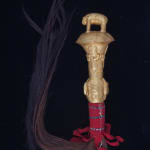Akan Gilt Wooden Flywhisk, 20th Century CE
Wood, Gold
10.25
PF.5896
The flywhisk is one of the penultimate symbols of royalty in Africa. In most cultures around the world, the wealth and power of a king or leader is measured by...
The flywhisk is one of the penultimate symbols of royalty in Africa. In most cultures around the world, the wealth and power of a king or leader is measured by the sumptuous nature of his possessions. The king is lofted above the status of mere mortals into the realm of the divine by the luxury of his regalia. In many cultures of Africa, colorful beads intricately woven into spectacular robes and hats are the costume of royalty. Both the vibrancy of the colours and the sophistication of the woven patterns would have wowed the public and given the king an appropriate royal aura. This flywhisk has been carved by a master artist working for the royal court. The impressive carving is further embellished by a thin layer of gold sheet that has been pounded onto the wood. This sumptuous wrapping makes the flywhisk even more stunning and befitting of a king. A bright red cloth covers the join of the horsehair whisk and the wooden handle. A baby elephant, trunk coiled into a ball, crowns the top of the handle. The neck is decorated by a series of intricately carved abstract motifs. The body is adorned by two carved faces, rendered in a fashion typical of the Akan group. The faces are separated by two crabs. This striking opposition most likely has a symbolic significance that relates to the king. One must picture the king seated high upon his throne, feet resting on a cushion, wearing beaded robes and jewelry during a royal ceremony. In the corner behind the king stands a servant who gently waves this whisk around the king, shooing away the pesky flies that attempt to land on his royal highness. When we imagine this ceremony, the true luxury of the king that this flywhisk represents becomes evident.



